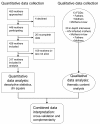The potential role of mother-in-law in prevention of mother-to-child transmission of HIV: a mixed methods study from the Kilimanjaro region, northern Tanzania
- PMID: 21749685
- PMCID: PMC3154866
- DOI: 10.1186/1471-2458-11-551
The potential role of mother-in-law in prevention of mother-to-child transmission of HIV: a mixed methods study from the Kilimanjaro region, northern Tanzania
Abstract
Background: In the Kilimanjaro region the mother-in-law has traditionally had an important role in matters related to reproduction and childcare. The aim of this study was to explore the role of the mothers-in-law in prevention of mother-to-child transmission (PMTCT) service utilization and adherence to infant feeding guidelines.
Methods: The study was conducted during 2007-2008 in rural and urban areas of Moshi district in the Kilimanjaro region of Tanzania. Mixed methods were used and included focus group discussions with mothers-in-law, mothers and fathers; in-depth interviews with mothers-in-law, mothers, fathers and HIV-infected mothers, and a survey of 446 mothers bringing their four-week-old infants for immunisation at five reproductive and child health clinics.
Results: The study demonstrated that the mother-in-law saw herself as responsible for family health issues in general and child care in particular. However she received limited trust, and couples, in particular couples living in urban areas, tended to exclude her from decisions related to childbearing and infant feeding. Mothers-in-law expected their daughters-in-law to breastfeed in a customary manner and were generally negative towards the infant feeding methods recommended for HIV-infected mothers; exclusive replacement feeding and exclusive breastfeeding.
Conclusions: Decreasing influence of the mother-in-law and increasing prominence of the conjugal couples in issues related to reproduction and child care, reinforce the importance of continued efforts to include male partners in the PMTCT programme. The potential for involving mothers-in-law in the infant feeding component, where she still has influence in some areas, should be further explored.
Figures
References
-
- WHO, Unicef, The Interagency Task Team (IATT) on Prevention of HIV. Guidance on global scale-up of the prevention of mother-to-child transmission of HIV Towards universal access for women, infants and young children and eliminating HIV and AIDS among children. Geneva; 2007.
-
- World Health Organization; United Nations Children's Fund; UNAIDS. Towards universal access: scaling up priority HIV/AIDS interventions in the health sector Progress report 2009. Geneva; 2009.
-
- Nyblade L, Field-Nguer ML. Women, Communities, and the Prevention of Mother-to-Child Transmission of HIV: Issues and Findings from Community Research in Botswana and Zambia. 2001.
-
- Moland KM. Mother's milk - an ambiguous blessing in the era of AIDS. The case of the Chagga in Kilimanjaro. African Sociological Review. 2004;8
Publication types
MeSH terms
LinkOut - more resources
Full Text Sources
Medical


